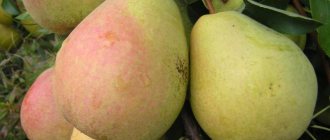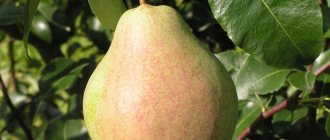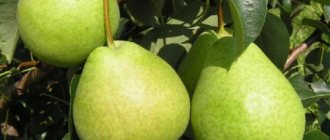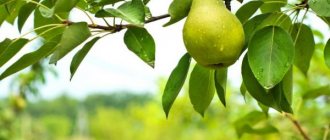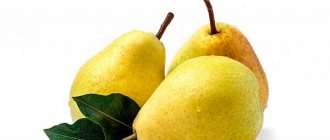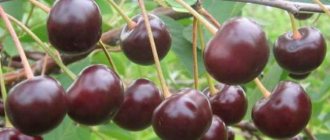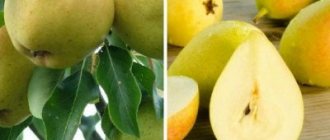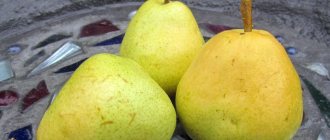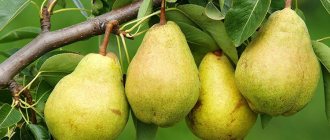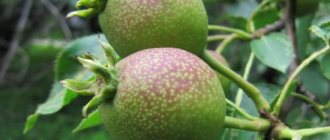History and description of the Honey pear variety
The Honey pear variety was obtained by open pollination of the French variety Bere Bosc at the Crimean Experimental Horticulture Station in 1964. This variety is also known as Crimean Honey. The authors of the variety are A.F. Mileshko, R.D. Babina and V.A. Yakimov. Accepted for state variety testing in 1992. The North Caucasus region is recommended for testing.
Honey - early-fruiting pear variety
Honey pear belongs to the late autumn varieties. The tree is not tall - up to 2 meters. The crown is pyramidal in shape, freely growing, of medium density. The ovaries are located on ringed and fruiting twigs. Fruiting occurs in 3–5 years. Early fruiting on a dwarf rootstock. The variety is partially self-fertile.
The fruits are large - weighing from 400 to 520 g. The shape of the fruit is short pear-shaped, unequal, the surface has a slight tuberosity and mild ribbing. The skin is smooth, thin, dry. The color of the fruit is greenish-yellow with a brownish outer blush. Subcutaneous dots are gray, small. The pulp of the fruit is juicy, cream-colored, slightly oily, tender, and very aromatic. The taste is excellent - the fruits are sweet, have a honey taste and melt in your mouth. According to a five-point system, the score is from 4.7 to 5 points.
Honey pear fruits are sweet and aromatic
The most suitable region for growing the variety is the North Caucasus, as well as the Moscow region and nearby regions of central Russia.
Contents of substances in fruits - table
| Substances | Content |
| Total sugars | 10,12% |
| Organic acids | 0,15% |
| Vitamin C | 5.93 mg/100 g fresh fruit weight |
In addition, Honey contains a large amount of vitamins, essential oils, macro- and microelements. Therefore, it is considered a medicinal plant and is recommended to increase the body's defenses. Pear also helps resist infectious diseases and has an anti-inflammatory effect.
Subspecies of Honey
Since the Honey tree is small in size, a columnar variety of pear was developed on the basis of this variety. The variety is quite young, appearing on the market about 20 years ago.
The columnar honey pear differs from the usual Honey Pear only in its compact size.
In terms of taste, the columnar pear does not differ from the usual Honey pear . The fruit grows weighing up to 400 g. But the shape and size of the tree will delight the gardener. It grows no more than 2 meters in height. It has no horizontal branches, so it does not grow in width. All branches of this plant are tightly pressed to the main trunk. Does not require pruning. Suitable for garden plots of any size. The distance between planted columnar pears should ideally be 1 meter. But in a small area you can plant it every 50 centimeters. The yield is 15–20 kg per tree.
The creators of columnar pears distinguish 5 subspecies, marked “G”:
- G-1 - refers to winter varieties. It has yellow, lumpy fruits weighing up to 250 g with juicy and tender pulp.
- G-2 - late autumn variety. The weight of the fruit does not exceed 200 g. The fruit is green, with brown spots, and lumpy. The taste is sweet and very aromatic. Ripens in late autumn.
- G-3 - early autumn variety. Large fruits, reaching a weight of 400 g. Pears are yellow in color, very bright. The pulp is tasty and tender.
- G-4 - autumn variety. The fruits are wide, large, weighing up to 300 g. The taste is excellent.
- G-5 - late summer variety. The weight of the fruit is 250 g. The fruits are yellow-brown in color, with excellent taste and aroma.
Honey has increased productivity, quick fruiting and winter hardiness. The shoots can withstand temperatures down to -25 °C.
Breeding and cultivation regions
This pear variety was bred by 3 breeders from Crimea - because of this, the crop was called Crimean Honey for a long time. The plant was created by open pollination of the French pear variety Bere Bosc in 1964. From 1992 to the present day, Medovaya has been undergoing state tests before entering the variety into the state register of the country.
Since this crop is unpretentious to the environment, it can be grown in almost all regions, but the largest amount of harvest is observed in the North Caucasus region.
Advantages and disadvantages
Among the advantages of the variety, the following should be noted:
- High precociousness. Fruiting occurs in the 3rd year.
- Stable yield. It is not affected by harsh climate or disease.
- The tree is small in size, which saves space in the garden.
- Large and tasty fruits.
- No tendency for ripe pears to shed.
- Unpretentiousness to soil and growing conditions.
- High resistance to the main diseases of pear: moniliosis and clasterosporiosis.
- Excellent appearance and transportability.
- Good winter hardiness.
Disadvantages of the Honey variety:
- If there are too many ovaries, the fruits may not be one-dimensional.
- High yields can cause weakening of the tree, which will negatively affect winter hardiness.
- Suitable only for regions with warm and temperate climates.
The best pollinators for the variety
Since the Honey pear variety is only partially self-fertile, to obtain an annual harvest, you must have at least 2 pollinating trees on your plot. An important condition for them is that they bloom at the same time as the pollinated plant and belong to the same group according to the timing of ripening. Suitable varieties include Chudesnitsa, Bere Bosk, Tavricheskaya, Bere Ardanpon.
Photo gallery of the best pollinators for the Honey pear
Pear variety Bere Ardanpon
Tavricheskaya pear variety
Bere Bosc pear
Pear variety Chudesnitsa
How to plant
Let's look at how to properly plant a honey pear in your garden.
The pear of this variety is a partially self-fertile variety. Thus, for pollination to take place and fruit ovaries to appear, it is necessary to have at least two pollinators on the site.
But it is not recommended to use the same variety of pear for this purpose, but it is better to prefer varieties such as:
- Bere Ardanpont;
Pear Bere Ardanpon
- Bere Bosc;
- Miraculous.
Other varieties of pears can also be used as pollinators: the main thing is that they have a period of flowering and fruit ripening similar to Honey. Pollinators should be placed 3 meters apart.
Choose the most suitable area in the garden for the plant. It should be south or southwest. It is important that the area is well lit by the sun most of the day, and that it is well protected from the wind. For wind protection, a building or some kind of artificial shield is suitable.
As for the soil, the Honey Pear will feel best in sandy loam soil with a slightly acidic or neutral reaction. If the soil is acidic, it must be limed: the cuttings cannot be planted in an acidic environment. But how an early summer pear variety seedling is planted is described in great detail in this video.
Experienced gardeners consider autumn to be the best time to plant this variety of pear: depending on climatic conditions, this may be the second part of September or the first part of October. At this time, the plant will be able to take root safely, since the ground has not yet frozen, but at the same time, the seedling will not begin to actively grow, since it is already quite cool.
If autumn planting is impossible for some reason, there is an option to plant a pear in the spring. In this case, the best time is mid-April to early May.
Landing Features
Landing dates
The most favorable time for planting pears is autumn. Work should begin after the leaves fall before the first frost arrives. In central Russia this is approximately the first half of October. But if for some reason you did not have time to do this in the fall, then it is quite possible to plant the seedling in the spring. You need to have time before mid-April - early May, depending on the region. The main thing is that the buds do not have time to bloom before the scheduled date. For spring planting, it is best to prepare the hole in the fall.
For columnar pears, spring planting is preferable. If the planted tree does not have time to take root before frost, the roots may die.
Planting material
It is best to purchase seedlings up to 3 years old. The older the tree, the greater the likelihood of damage to the roots during digging and transportation. Young trees have the highest percentage of adaptation and survival.
Determining the age of a Honey pear seedling is very simple: if it is a little over 1 meter in height, the thickness of the trunk is about 1 centimeter, and there are no branches on the trunk, then the tree is 1 year old. An annual plant must have developed buds located from the middle of the trunk to the top. Branches will subsequently develop from them. A two-year-old seedling will have from 3 to 5 lateral branches about 30 centimeters long. The plant will reach a height of 1.5 m, and the height of the trunk (the distance from the root collar to the side branches) should be at least 50 centimeters.
Carefully examine the bark of the seedling. It should not be dry and wrinkled. The kidneys must be well developed. Be sure to pay attention to the condition of the root system. There should be no growths or swellings on the roots - these are possible signs of the disease. In addition, they must be moist. A good root system of a young pear should have three thick main roots, covered with additional thin roots, similar to a dense network. The length of the roots of a one-year-old is at least 20 centimeters, and that of a two-year-old is 30 cm. When transporting a young seedling, it is necessary to wrap its roots with a wet cloth.
Pear seedlings must have a developed root system
Carefully examine the top of the tree - it should be mature and woody. This indicates that the pear was dug up at the right time. If you bought a Honey seedling with a grassy apical shoot, then you should not plant it in a permanent place right away. It is best to bury it at an angle in a secluded place, preferably so that the seedling is covered with snow. In this case, the young tree has a better chance of surviving the winter.
Site selection
The pear tree does not like transplants, so we carefully select a permanent planting location. We give preference to the southern, southwestern and western areas. The place should be well lit, but not hot - the pear tree does not like the sun. You also need protection from cold northern winds - a high fence or building. Low-lying and waterlogged places with subsoil water are not suitable; in such places, the root system rots, the crown becomes dry, the tree weakens and dies. The soil should be loose and fertile, air and water permeable. Acidic soils are not suitable .
Preparing the landing site
To plant a pear, you need to prepare a hole in advance. Its size depends on the rootstock. If the tree is highly developed, then the hole should be 80 centimeters in diameter and about 100 centimeters deep. For underdeveloped young trees - 60 cm in diameter and approximately 80 cm deep. The same dimensions of the hole are suitable for planting a columnar pear.
The top fertile layer of soil should be set aside when digging a hole. Depending on the size of the pit, first of all organic fertilizers are placed in it - peat, humus 2-3 buckets, 1-2 buckets of coarse sand, and then phosphorus-potassium fertilizers. For one pit you will need them - 3 tablespoons of potassium sulfate, 1 cup of superphosphate. Mix everything and add 2 buckets of water. Water helps compact the soil. We leave the pit in this state for a week.
Step by step process
It is best to plant pears in the spring.
- Before planting the seedling, we drive a peg into the center of the hole; its height above the ground should be 50 centimeters. We place this peg so that the tree is on the north side of it. This arrangement will protect the trunk in spring and summer from overheating and sunburn, and will also serve as a support for the young tree.
- We pour the top fertile layer of soil into the hole, which we set aside when digging, so that it forms a cone or mound.
- Then we take the seedling and cut off the foliage - this must be done so that the plant does not lose moisture, then we cut off the damaged roots to healthy tissue. The more roots, the better the tree will take root. The root system can be dipped in a solution of heteroauxin mixed with earthen mash. This will protect the roots and promote better establishment.
- We place the prepared plant on a mound and carefully straighten the roots along its sides, and then add soil, shaking the plant. This must be done so that the earth fills all the voids between the roots and the soil. The earth should be well compacted, but you should not trample it with your feet. It is better to spill water and add soil 3-4 times.
- When planting, you need to ensure that the root collar (the place where the trunk meets the root) is 5–6 centimeters above the soil level.
- Tie the tree to a stake using fabric or film; the wire can seriously injure the young seedling.
- At the border of the hole, around the trunk, we build a roller of earth from the earth, forming a hole for further watering. You need to pour 2 buckets of water into the hole.
The subtleties of planting a tree - video
Tree care
Watering frequency and hole care
If you planted a pear in the fall, one good watering will be enough. If the planting is in spring, then you will have to water it often - once every 3 days, and in very hot weather almost every day. The watering rate is 2 buckets for each year of the plant’s life. Watering is best done by sprinkling. If this is not possible, then carefully pour water into the hole in several stages.
After watering, the soil in the hole must be carefully loosened and mulched. Mown and slightly dried grass is suitable for this. A thick layer of mulch will retain moisture longer and the frequency of watering can be reduced.
Trimming
Stages of crown formation
The pear has a weak shoot-forming ability, so the growths remain bare for a long time. Pruning is best done in the spring - at the end of March (before the start of sap flow). A sharp garden pruner is suitable for pruning.
- Annual seedlings do not need to be pruned. The first pruning is done in the second year after planting. The trunk is shortened by 1/4 of the length, which contributes to the formation of the future crown.
- For two-year-old seedlings, choose 2 or 3 well-developed branches and a central conductor. The remaining branches are cut into a ring (at the base of the branch there is a so-called ring - a ring-shaped influx containing cells that promote rapid wound healing). The selected branches are cut to 1/3 of the length, and the central conductor is cut so that it is 15–20 centimeters higher than the upper side branch. This is how the first tier of the crown is formed.
- In the third year, the second tier is formed. To do this, select two well-developed branches at a height of 50–70 centimeters from the level of the first tier and align them in length. They will make up the second tier of the crown. The branches located between the tiers are greatly shortened. The central conductor is cut by 10–20 centimeters. Competitors of the selected branches that form the second level are pruned into a ring.
- In the fourth year, we plant another main branch, which will be located 40 centimeters above the second-level branches. The branches located between the tiers are greatly shortened, and competing ones are cut into a ring. After 2 years, when the upper branch takes a vertical position, the central conductor above it should be cut off.
Correct and regular pruning promotes rapid development of the pear and regular fruiting.
Secrets of proper pruning - video
First flowering
This primarily applies to columnar pears planted in spring. If it blooms, it is better to remove the flowers so that the pear has enough strength to take root in a new place. Next year we leave a few flowers and no more than 3 ovaries.
Preparing for winter
Before the onset of cold weather, the young pear must be well watered by pouring 3 buckets of water into the hole. 5-6 buckets of water are poured under mature trees. Potassium-phosphorus fertilizers applied during planting contribute to better winter hardiness.
The trunk of the pear and part of the lower branches must be whitened before wintering. This will help the pear avoid thermal burns. For young seedlings, the danger is not only from frost, but also from rodents. You can protect a tree from them by tying its trunk with spruce branches or old tights or stockings. If the winter is snowy, then it is good to heat up as much snow as possible onto the root hole, this will protect the roots from freezing. You can cover the roots under a layer of sawdust or straw. This is especially true for the columnar pear. All these precautions are necessary in the first 4 years. Under mature trees, in preparation for winter, all fallen leaves and rotten fruits are removed. Pests can overwinter under them.
Feeding and fertilizers
In the first year of planting, we do not fertilize the Honey Pear; everything necessary for its development has already been added during planting. In the second year of planting, we add organic matter and mineral fertilizers. In the spring, when active sap flow begins, the pear needs to be fed with organic fertilizers. Manure contains 0.5% nitrogen, 0.25% phosphorus and 0.4% potassium. It is applied under the tree at the rate of 1–2 kilograms per 1 square meter and mixed with the ground. This feeding should be done annually. Nitrogen is important in the spring, but after June it does not need to be used, since the pear begins to prepare for winter, and active growth during this period must be excluded.
Mineral fertilizers are applied along the edge of the crown in the tree trunk circle into the depressions made.
Doses of autumn application of mineral fertilizers for pear trees - table
| Tree age | Potassium, g/m² | Phosphorus, g/m² | How to deposit |
| 4–12 years | 6 | 4 | Into the soil to a depth of 40 cm |
| 12–20 years | 8 | 6 | |
| More than 20 years | 12 | 8 |
Doses for young seedlings are 2 times less than for an adult tree. The best fertilizer for young plants is a non-concentrated solution of chicken droppings or mullein, which is poured onto moist soil.
The pear also needs foliar feeding. Before flowering, spray with a 3% superphosphate solution. This treatment stimulates tree growth and increases productivity. Treatment with a 2% percent urea solution strengthens the tree. It is carried out on the 10th day after flowering.
If a pear grows in acidic soils, then it needs calcium. The soil under the tree is sprinkled with ash, 3–4 cups per 1 m². This procedure is carried out in late summer - early autumn. The ash is applied to the moistened soil, then watering is carried out.
Subspecies of the proposed variety
Several columnar varieties have been bred based on Honey. All subspecies are assigned the labeling class “G”. The columnar tree has no horizontally extending branches, it grows up to 1.95 meters in height, all its branches are pressed against the main trunk. Columnar pear does not require crown formation.
Subspecies of columnar pear:
- G1 - winter variety, fruits - yellowish, lumpy, weighing up to 245 grams;
- G2 - late autumn variety, fruits - yellowish-green, with an orange-brown blush, lumpy, weighing up to 205 grams;
- G3 - early autumn variety, fruits - bright yellow, weighing up to 405 grams;
- G4 - autumn variety, fruits - large, wide, weighing up to 305 grams;
- G5 is a late-summer variety, the fruits are yellowish-brown, weighing up to 245 grams.
Diseases and pests
Honey is resistant to the main diseases of pears - moniliosis and clasterosporia. However, prevention should also be carried out against other diseases and pests.
Prevention and control of diseases - table
| Diseases | Signs of defeat | Prevention | Control measures |
| Scab | Spots appear on the leaves, which gradually grow and change color. Young shoots are affected. The fruits are covered with velvety olive spots. | Regularly remove and destroy infected parts of the tree and fruits. | Before bud break, treat with 3% Bordeaux mixture. The bud is treated with Horus -2 grams per 10 liters. |
| Rust | Red-orange spots appear on the leaves. Affected leaves dry out and fall off. |
| Speed - before leaves appear, before flowering, after flowering (2 ml per bucket of water). |
| Fruit rot | Brown spots appear on the surface of the fruit. The fruits fall. | All infected fruits are removed and destroyed. Fallen fruits should also be destroyed. | Bottom - 100 grams per 10 liters of water for dormant buds. |
Signs of pear disease damage - photo gallery
Fruit rot is a fungal disease that affects most garden crops.
Rust is the most common fungal disease of pears.
Scab is a common disease of pear and apple trees.
Prevention and pest control - table
| Pests | Signs of pest damage | Prevention | Control measures |
| Medyanitsa | They feed on cell sap, which leads to deformation of leaves and fruits. They fall off prematurely. |
| Aktar - 1.4 g per 10 liters of water. Apply in dry and windless weather, preferably in the evening. |
| Aphid | Sucks juices from the leaf blade, which leads to the suspension of leaf development, curling and death. |
| In early spring, treatment with ZOV (0.6 liters per 10 liters of water) - before buds open. |
| Pear moth | Damaged fruits dry out and fall to the ground. |
| Agravertine before and after flowering - 5 ml per 1.5 liters of water. |
Harmful insects in the photo
Pear moth
Medyanitsa
Aphid
Proper pruning and watering
Let's learn the main features of caring for the Honey pear variety growing in the garden.
Trimming
The plant needs good sunlight - this determines how quickly the fruits ripen and their size. Therefore, regular thinning of the crown of the Honey Pear is necessary. In addition, pruning will allow you to promptly get rid of young growth, the maintenance of which the tree spends nutrients and energy.
Pear pruning
Honey pear needs crown-forming pruning - this is carried out in the second, third and fourth year after rooting. After the fourth year, the crown will already be properly formed, and all you have to do is maintain it in good condition by removing excess shoots, as well as old, dried, damaged branches.
Honey pear needs good watering, especially if the summer is dry. If the plant is young, then it requires weekly watering: 10 liters of water must be used in one procedure.
An adult fruit-bearing tree is usually moistened twice per season. The first time watering occurs before flowering, and the second time - immediately after flowering. After watering, it is advisable to mulch the root circle with peat, straw or humus: this measure will help retain moisture in the soil.
Maybe
Harvesting
The productivity of Medovaya is much higher than similar varieties - from one young tree you can collect up to 110 kilograms of juicy and appetizing fruits. The ripeness of the fruit occurs in the second half of September. Pears do not fall off; they must be picked by hand, trying to preserve the stalk.
It is undesirable to collect fruits that have not reached technical maturity. Such a pear does not ripen during storage, hardens and does not acquire the sweetness and aroma characteristic of this variety. The ripeness of the fruit is determined by taste and visual control. The stalk is easily separated from the ripe fruit. The pulp should be cream-colored, tender, but not loose. The color must match the variety.
As for columnar varieties, their ripening occurs at different times - from the beginning of August to the first ten days of October.
Pears are best stored in the refrigerator at a temperature of +1 °C - until January. Before storing, do not wipe the fruit under any circumstances, do not try to wipe off the waxy coating from them - it protects the pear from spoilage. Can be stored in a cool, dry cellar at +4 °C, wrapped in paper and placed in a single layer on shelves or in boxes. If the fruits are whole, they can easily last for 2 months.
Honey pears make aromatic seasonal preparations
Of course, Honey Pear is best consumed fresh. But if the harvest was large, then you can prepare canned juices, compotes and jams (just don’t overdo it with sugar). This variety is not suitable for freezing.
High resistance to the main diseases that affect pears, early fruiting and large yields are not all the advantages of the Medovaya variety. Let's add easy care and juicy, sweet fruits. It is these qualities that the pear wins new fans among gardeners.
- Author: Irina Morenko
Good day! My name is Irina. I live in a wonderful place - Crimea. By education - a teacher. I really love nature and animals. I have been interested in floriculture for a long time, but I have only just begun to master the wisdom of gardening. My motto is: live forever, learn forever. Rate this article:
- 5
- 4
- 3
- 2
- 1
(9 votes, average: 5 out of 5)
Share with your friends!
Reviews from summer residents
- Unfortunately, this variety of pears does not grow in our summer cottage, but every year we receive treats from our neighbors. This variety has been bearing fruit abundantly for many years now, every year, so they treat us. The Honey pear variety really has very sweet, honey-like fruits with honey pulp that “melts in your mouth.”
- This pear has been growing in my dacha for ten years now. I haven’t measured how much the harvest yields, they just enjoy the taste of the fruits with their family every year. My children are already adults, but every year they take pears to eat and make jam, and my wife and I also have time to enjoy plenty of them and prepare them for the winter. We usually don’t store fruits fresh, but in small quantities they last a really long time in the refrigerator.
- Honey is deservedly my favorite variety of pear. My son planted the tree eight years ago at his dacha. The plant is small and compact, but always produces a good harvest. Pears are very tasty, soft, juicy and sweet; we use them instead of dessert during the season. We kept some for our grandchildren in the cellar, they are basically good, but they were eaten in less than two months.
